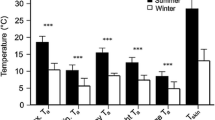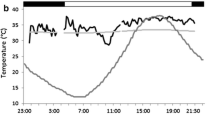Abstract
Many small mammals are heterothermic endotherms capable of maintaining an elevated core body temperature or reducing their thermoregulatory set point to enter a state of torpor. Torpor can confer substantial energy savings, but also incurs ecological costs, such as hindering allocation of energy towards reproduction. We placed temperature-sensitive radio transmitters on 44 adult Rafinesque’s big-eared bats (Corynorhinus rafinesquii) and deployed microclimate dataloggers inside 34 day roosts to compare the use of torpor by different sex and reproductive classes of bats during the summer. We collected 324 bat-days of skin-temperature data from 36 females and 4 males. Reproductive females employed fewer torpor bouts per day than non-reproductive females and males (P < 0.0001), and pregnant and lactating females had higher average (P < 0.0001) and minimum (P < 0.0001) skin temperatures than non-reproductive females. Pregnant females spent less time torpid (P < 0.0001) than non-reproductive females, but lactating females used relatively deep, long torpor bouts. Microclimates varied inside tree species with different configurations of entrances to the roost cavity (P < 0.0001). Bats spent more time torpid when roosting in water tupelo (Nyssa aquatica) trees possessing only a basal entrance to the cavity (P = 0.001). Of the tree species used as roosts, water tupelo cavities exhibited the least variable daytime and nighttime temperatures. These data demonstrate that use of summer torpor is not uniform among sex and reproductive classes in Rafinesque’s big-eared bat, and variation in microclimate among tree roosts due to species and structural characteristics facilitates the use of different thermoregulatory strategies in these bats.




Similar content being viewed by others
References
Aldridge HDJN, Brigham RM (1988) Load carrying and maneuverability in an insectivorous bat: a test of the 5 % ‘rule’ of radio-telemetry. J Mammal 69:379–382
Baker MD, Lacki MJ (2006) Day-roosting habitat of female long-legged myotis in ponderosa pine forests. J Wildl Manag 70:207–215
Bayless ML, Clark MK, Stark RC, Douglas BS, Ginger SM (2011) Distribution and status of eastern big-eared bats (Corynorhinus spp.). In: Loeb SC, Lacki MJ, Miller DA (eds) Conservation and management of big-eared bats: a symposium, US Department of Agriculture, Forest Service, Southern Research Station, Ashville, pp 13–25
Bennett FM, Loeb SC, Bunch MS, Bowerman WW (2008) Use and selection of bridges as day roosts by Rafinesque’s big-eared bats. Am Midl Nat 160:386–399
Betts BJ (2010) Thermoregulatory mechanisms used in a maternity colony of Townsend’s big-eared bats in northeastern Oregon. Northwest Nat 91:288–298
Boyles JG, Smit B, McKechnie AE (2011a) A new comparative metric for estimating heterothermy in endotherms. Physiol Biochem Zool 84:115–123
Boyles JG, Smit B, McKechnie AE (2011b) Does use of the torpor cut-off method to analyze variation on body temperature cause more problems than it solves? J Thermal Biol 36:373–375
Brigham RM, Willis CKR, Geiser F, Mzilikazi N (2011) Throwing the baby out with the bath water: should we abandon the use of body temperature thresholds to quantify the expression of torpor? J Thermal Biol 36:376–379
Brunet-Rossinni AK, Wilkinson GS (2009) Methods for age estimation and the study of senescence in bats. In: Kunz TH, Parsons S (eds) Ecological and behavioral methods for the study of bats, 2nd edn. Johns Hopkins University Press, Baltimore, pp 315–325
Chruszcz BJ, Barclay RMR (2002) Thermoregulatory ecology of a solitary bat, Myotis evotis, roosting in rock crevices. Func Ecol 16:18–26
Dzal YA, Brigham RM (2012) The tradeoff between torpor use and reproduction in little brown bats (Myotis lucifugus). J Comp Physiol B. doi:10.1007/s00360-012-0705-4
Florant GL, Heller HC (1977) CNS regulation of body temperature in euthermic and hibernating marmots (Marmota flaviventris). Am J Physiol 232:R203–R208
Geiser F (2004) Metabolic rate and body temperature reduction during hibernation and daily torpor. Annu Rev Physiol 66:239–274
Geiser F, Christian N, Cooper CE, Körtner G, McAllan BM, Pavey CR, Turner JM, Warnecke L, Willis CKR, Brigham RM (2008) Torpor in marsupials: recent advances. In: Lovegrove BG, McKechnie AE (eds) Hypometabolism in animals: torpor, hibernation and cryobiology. Thirteenth international hibernation symposium. University of Kwazulu-Natal, Pietermaritzburg, pp 279–306
Geiser F, McAllan BM, Brigham RM (2005) Daily torpor in a pregnant dunnart (Sminthopsis macroura Dasyuridae: Marsupalia). Mammal Biol 70:117–121
Geiser F, Pavey CR (2007) Basking and torpor in a rock-dwelling desert marsupial: survival strategies in a resource-poor environment. J Comp Physiol B 177:885–892
Hamilton IM, Barclay RMR (1994) Patterns of daily torpor and day-roost selection by male and female big brown bats (Eptesicus fuscus). Can J Zool 72:744–749
Heller HC, Colliver GW, Beard J (1977) Thermoregulation during entrance into hibernation. Pflügers Arch 369:55–59
Hurst TE, Lacki MJ (1999) Roost selection, population size and habitat use by a colony of Rafinesque’s big-eared bats (Corynorhinus rafinesquii). Am Midl Nat 142:363–371
Jones C (1977) Plecotus rafinesquii. Mammal Species 69:1–4
Johnson JS, Lacki MJ (2011) Foraging and roosting ecology of Rafinesque’s big-eared bat at the northern edge of the range. In: Loeb SC, Lacki MJ, Miller DA (eds) Conservation and management of big-eared bats: a symposium. United States Department of Agriculture Forest Service, Southern Research Station, Ashville, pp 129–138
Johnson JS, Kropczynski JK, Lacki MJ, Langlois GD (2012) Social networks of Rafinesque’s big-eared bats (Corynorhinus rafinesquii) in bottomland hardwood forests. J Mammal 93:1545–1558
Kerth G, Weissmann K, König B (2001) Day roost selection in female Bechstein’s bats (Myotis bechsteinii): a field experiment to determine the influence of roost temperature. Oecologia 126:1–9
Krutzsch PH (2000) Anatomy, physiology and cyclicity of the male reproductive tract. In: Crichton EG, Krutzsch PH (eds) Reproductive biology of bats. Academic Press, London, pp 91–137
Kurta A, Bell GP, Kunz TH, Nagy KA (1989) Energetics of pregnancy and lactation in free-ranging little brown bats (Myotis lucifugus). Physiol Zool 62:804–818
Kurta A, Kunz TH, Nagy KA (1990) Energetics and water flux of free-ranging big brown bats (Eptesicus fuscus) during pregnancy and lactation. J Mammal 71:59–65
Lausen CL, Barclay RMR (2003) Thermoregulation and roost selection by reproductive female big brown bats (Eptesicus fuscus) roosting in rock crevices. J Zool Lond 260:235–244
Lehmer EM, Bossenbroeck JM, Van Horne B (2003) The influence of environment, sex and innate timing mechanism on body temperature patterns of free-ranging black-tailed prairie dogs (Cynomys ludovicianus). Physiol Biochem Zool 76:72–83
McLean JA, Speakman JR (1999) Energy budgets of lactating and non-reproductive brown long-eared bats (Plecotus auritus) suggest females use compensation in lactation. Func Ecol 13:360–372
National Oceanic and Atmospheric Administration (2002) Monthly station normals of temperature, precipitation, and heating and cooling degree days 1971–2000: Kentucky. Asheville, NC
Ormsbee PC, McComb WC (1998) Selection of day-roosts by female long-legged myotis in the central Oregon Cascade range. J Wildlife Manag 62:596–603
Pretzlaff I, Kerth G, Dausmann KH (2010) Communally breeding bats use physiological and behavioural adjustments to optimize daily energy expenditure. Naturwissenschaften 97:353–363
Racey PA (1973) Environmental factors affecting the length of gestation in heterothermic bats. J Reprod Fertil 19:175–189
Racey PA, Swift SM (1981) Variations in gestation length in a colony of pipistrelle bats (Pipistrellus pipistrellus) from year to year. J Reprod Fertil 61:123–129
Racey PA, Speakman JR (1987) The energy costs of pregnancy and lactation in heterothermic bats. In: Loudon ASI, Racey PA (eds) Reproductive energetics in mammals. Oxford University Press, New York, pp 107–125
Racey PA (2009) Reproductive assessment of bats. In: Kunz TH, Parsons S (eds) Ecological and behavioral methods for the study of bats, 2nd edn. Johns Hopkins University Press, Baltimore, pp 249–364
Rambaldini DA, Brigham RM (2008) Torpor use by free-ranging pallid bats (Antrozous pallidus) at the northern extent of their range. J Mammal 89:933–941
Rice C (2009) Roosting ecology of Corynorhinus rafinesquii (Rafinesque’s big-eared bat) and Myotis austroriparius (southeastern myotis) in tree cavities found in a northeastern Louisiana bottomland hardwood forest streambed. Thesis, University of Louisiana at Monroe
Ruczyński I (2006) Influence of temperature on maternity roost selection by noctule bats (Nyctalus noctula) and Leisler’s bats (N. leisleri) in Białowieża Primeval Forest, Poland. Can J Zool 84:900–907
Solick DI, Barclay RMR (2006) Thermoregulation and roosting behavior of reproductive and nonreproductive female western long-eared bats (Myotis evotis) in the Rocky Mountains of Alberta. Can J Zool 84:589–599
Speakman JR (1999) The cost of living: field metabolic rates of small mammals. Adv Ecol Res 30:177–297
Speakman JR (2008) The physiological costs of reproduction in small mammals. Phil Trans R Soc B 363:375–398
Speakman JR, Thomas DW (2003) Physiological ecology and energetics of bats. In: Kunz TH, Fenton MB (eds) Bat ecology. University of Chicago Press, Chicago, pp 430–490
Stamper JL, Zucker I, Lewis DA, Dark J (1998) Torpor in lactating Siberian hamsters subjected to glucoprivation. Am J Physiol Regul Integr Comp Physiol 274:R46–R51
Stawski C, Geiser F (2010) Fat and fed: frequent use of summer torpor in a subtropical bat. Naturwissenschaften 97:29–35
Storey KB, Heldmaier G, Rider MH (2010) Mammalian hibernation: physiology, cell signaling, and gene controls on metabolic rate depression. Top Curr Genet 21:227–252
Studier EH (1981) Energetic advantages of slight drops in body temperature in little brown bats, Myotis lucifugus. Comp Biochem Physiol 70A:537–540
Trousdale AW, Beckett DC, Hammond SL (2008) Short-term roost fidelity of Rafinesque’s big-eared bat (Corynorhinus rafinesquii) varies with habitat. J Mammal 89:477–484
Turbill C, Geiser F (2006) Thermal physiology of pregnant and lactating female and male long-eared bats, Nyctophilus geoffroyi an N. gouldi. J Comp Physiol B 176:164–172
Turbill C, Körtner G, Geiser F (2003) Natural use of heterothermy by a small, tree-roosting bat during summer. Physiol Biochem Zool 76:868–876
Webb PI, Speakman JR, Racey PA (1993) The implications of small reductions in body temperature for radiant and convective heat loss in resting endothermic brown long-eared bats (Plecotus auritus). J Thermal Biol 18:131–135
Wilde CJ, Knight CH, Racey PR (1999) Influence of torpor on milk protein composition and secretion in lactating bats. J Exp Biol 284:35–41
Willis CKR (2007) An energy-based body temperature threshold between torpor and normothermia for small mammals. Physiol Biochem Zool 80:643–651
Willis CKR, Brigham RM (2007) Social thermoregulation exerts more influence than microclimate on forest roost preferences by a cavity-dwelling bat. Behav Ecol Sociobiol 62:97–108
Willis CKR, Brigham RM, Geiser F (2006) Deep, prolonged torpor by pregnant, free-ranging bats. Naturwissenschaften 93:80–83
Acknowledgments
Funding for this project was provided by the Kentucky Department of Fish and Wildlife Resources (KDFWR) and the University of Kentucky, College of Agriculture. We thank G. Langlois, D. Fraser, J. Grider, C. Farr, and H. Comstock for their hard work and dedication in the field, without which this project would not have been possible. We also thank J. MacGregor, B. Hines, and D. Baxley of the KDFWR for their guidance. All methods were approved by the University of Kentucky Institutional Animal Care and Use Committee (IACUC No. A3336-01). This investigation is connected with a project of the Kentucky Agricultural Experiment Station (KAES No. 12-09-093) and is published with the approval of the director.
Author information
Authors and Affiliations
Corresponding author
Additional information
Communicated by G. Heldmaier.
Rights and permissions
About this article
Cite this article
Johnson, J.S., Lacki, M.J. Summer heterothermy in Rafinesque’s big-eared bats (Corynorhinus rafinesquii) roosting in tree cavities in bottomland hardwood forests. J Comp Physiol B 183, 709–721 (2013). https://doi.org/10.1007/s00360-012-0728-x
Received:
Revised:
Accepted:
Published:
Issue Date:
DOI: https://doi.org/10.1007/s00360-012-0728-x




